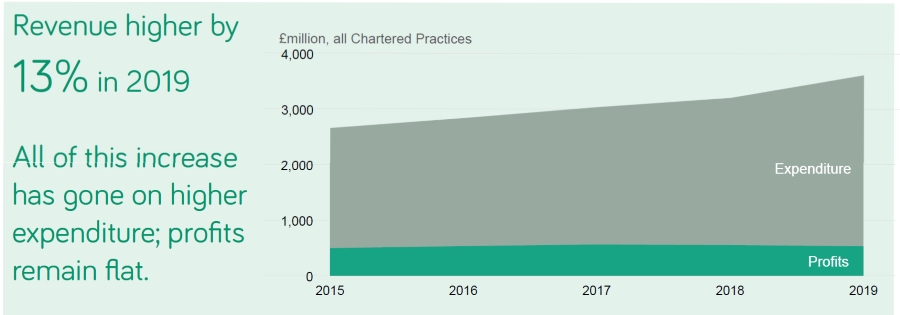Technology
Group of British Design Firms Petitions Autodesk for More Revit Development
Firms including Zaha Hadid Architects, say they're seeing cost of Revit increase while using it less

The RIBA Chartered Practice Benchmarking Report highlights the increasing cost of ownership of design‐based software as part of the overall growth in costs that the design industry is facing.
Graphic Courtesy of RIBA
A group of 25 architectural design firms—including Zaha Hadid Architects, Grimshaw and Stirk, and Harbour + Partners—that represents 5,000 paid seats and $22 million of spending from 2015 to 2019 on Autodesk Revit software, wrote a public letter to Autodesk CEO Andrew Anagnost dated July 27 asking for more development of the software and relaying concerns about its increasing cost of ownership.
A questionnaire was circulated by the Royal Institute of British Architects earlier this year among IT directors and digital design leaders at the 25 firms, and the letter is based on their collective responses. The results of that survey are part of RIBA's Chartered Practice Benchmarking Report for 2020.
"[The report] highlights the increasing cost of ownership of design‐based software as part of the overall growth in costs that the design industry is facing. Even before the COVID‐19 pandemic costs were under significant scrutiny and the value added by software vendors is now being questioned as never before," the letter reads.
RIBA's benchmarking report shows that In the period between 2015 and 2019 most practices who participated in the survey had at least 5 different software licensing models in play, ranging from individual product licenses, to suites, through to collections which included licenses for several different products purchased as a package. Earlier this year, Autodesk notified customers it would be ending its multi-user, enterprise-wide licenses that many firms had used to keep their software costs low. By moving to "named user licenses," Autodesk now requires customers to buy a license for every single user, as opposed to allowing a smaller number of dynamic network licenses which could be shared among a large number of employees at a firm.
Customers who previously bought perpetual software licenses have seen maintenance fees grow by 5%, 10% and 20% in the last 3 years as an "incentive" to switch to Autodesk's subscription model, which the San Rafael, Calif.-based vendor has been migrating to as its preferred sales method in the last decade. Those who have not switched from multi-user licenses will not receive ongoing maintenance patches, rendering the software potentially unusable as operating systems and computer hardware change.
Perpetual licenses, which had no user limit, were scheduled to end earlier this year as a result of the shift to the subscription selling model. That sunset date has been since pushed back to August of this year due to the COVID-19 pandemic. The letter states that "[design] practices would be less worried by these cost increases if they were mirrored by productivity improvements and a progressive software development program."
The signers of the letter contend that costs for Revit have gone up 70% from 2015 to 2019, and that development on the software has lagged during that same period. “Where once Autodesk Revit was the industry enabler to smarter working, it increasingly finds itself a constraint and bottleneck. Practices find that they are paying more but using Revit less because of its constraints,” the letter states. Autodesk acquired Revit in 2002, and has released updates to the software since.
The design firms signing the letter cited Revit's limitations, such as not being able to access multiple CPU cores and how it makes lines, as things they would like to see more development dollars devoted to. Renato Gilberti, senior designer and associate partner at Chicago's BKV Group, said that Revit makes boxes, rectangles and straight lines very well, but is not the tool he needs to digitally create the curves and prismatic forms of modern designs and he would like to see the design platform, now owned by Autodesk for nearly 20 years, to either have more development dollars devoted to it or see it be replaced by a new design platform that better fits a modern designer's needs.
An Autodesk spokesperson told ENR “we are aware of the open letter from design firms and are currently reviewing its contents to inform our response.”




